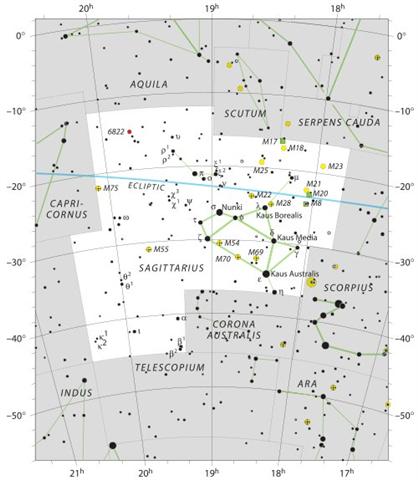1. In the Tahitian star pillar list we have seen how Arcturus and Procyon are like twins, with similar names and as number 6 and 7 possibly referring to winter respectively summer:
The distance from Procyon to Arcturus is 216 - 116 = 100 days, certainly a fact which had been noted. If we had put Procyon at Ga4-5, then Arcturus ('the pillar to stand by') would have been at Ga8-12:
But 280 - 100 = 180 is probably instead the distance from Phaed (Ana-iva) and spring equinox.
30 glyphs after Rehua we have so far no star listed. We can calculate what right ascension such a star would have. It would have a right ascension which is ca 30 * 4 = 120 minutes higher than 16h 26m and such a star could be Kaus Borealis, the northern end of the bow in Sagittarius:
It is said (according to Wikipedia) that the arrow of this constellation points towards the star Antares, 'the heart of the scorpion'. The Messier (M) numbers refer to other galaxies and there are several such listed on the map, e.g. immediately to the north of (borealis) the bow (kaus) where the ecliptic goes. Furthermore, Sagittarius is located in the direction where our own galaxy has its center. Sagittarius is aiming his bow at Antares and at the opposite end of the sky there is the Babylonian Arrow. Maybe, we can imagine, the arrow kills the old ruler, the 'winter year':
Sun's rays are like arrows and on Easter Island Rehua 'personified' summer. Beyond the 7th month of 'land' in the sky comes the 'sea', where the ecliptic is submerged below the 'river' of the Milky Way. At the same time, though, Sun will have 'alighted' on earth below (south of the equator). Sagittarius therefore becomes the 1st month of summer, when Sun is close above rejuvenating earth. We can imagine Sun shooting his arrows down to earth to make her fruitful. The idea of Sun's rays reaching down into the earth below was once an important concept on Malta (cfr at The Mad Hatter): ... Then I become aware of ... a presence - a faint, ghostly glimmering, like moonglow, that has appeared on the solstice stone. I don't know how long it lasts, a second or two only I would guess, but while it is there it seems less like a projection - which I know it to be - than something immanent within the stone itself. And it seems to function as a herald for it fades almost as soon as it has appeared and in its place the full effect snaps on - instantaneously. It wasn't there, and then it's there. As Chris had described, the effect does curiously resemble a poleaxe, or a flag on a pole, and consists of a 'shaft', narrow at the base but widening a little towards the top, running up the left hand side of the solstice stone, surmounted by a right-facing 'head' or 'flag'. An instant later an almond-shaped spot of light, like an eye, appears a few centimeters to the right of the 'flag' and the effect is complete. Weirdly - I do not claim it has any significance - this flag-on-a-pole symbol is the ancient Egyptian hieroglyph neter, meaning 'god', or 'a god' - and not to be understood at all in the Judaeo-Christian usage of that word but rather as a reference to one of the supernatural powers or principles that guide and balance the universe. Manifested here, in this strange Stone Age temple, it glows, as though lit by inner fire.' North of the equator, e.g. in ancient Babylonia, the arrival of summer would have coincided with the arrival of 'land' in the sky. The Bow constellation is 'antipodal' to Sagittarius:
If we imagine Sun as a great bird in the sky, then another interpretation is possible. The arrow (with bird's feathers at its end) is not pointing at Mother Earth but at the Sun bird. Sagittarius aims his arrow at the heart of Scorpio (Antares), where the Sun bird has his habitat this time of the year. Afraid the Sun bird therefore takes to his wings and flies upwards, which leaves a trail in form of the Milky Way between Sagittarius and Gemini. As to the other archer, she seems to compel the Sun bird to leave the Milky Way and once again move along the ecliptic. Such could be the origin of the 'landscape' imagined in the night sky. My details are certainly not exact, but I think the main picture is this old division of the sky into 'land' and 'sea'. The precession has moved Gemini and the rest of the picture away from the inital correspondence betweend the map of the sky and the map of time down on earth (north of the equator). However, the structure probably was remembered up to modern times. "This [σ] has been identified with Nunki of the Euphratean Tablet of the Thirty Stars, the Star of the Proclamation of the Sea, this Sea being the quarter occupied by Aquarius, Capricornus, Delphinus, Pisces, and Pisces Australis. It is the same space in the sky that Aratos designated as Water ..." (Allen) Perhaps the G tablet enumerates 16 stars, because 472 / 360 * 12 = 16 would give one star for each glyph line. South of the equator there could have been an 'opposite' version of the 30-star tablet of Babylonia, and 16 * 29½ = 472 is in contrast to 30 * 12 = 360. Instead of each star 'measuring' 12 days each star in the G text could measure a lunar month. |
|||||||||||||||||||||||||||||||||||||||||||||||||||||||||||||||||||||||||||||||||||||||||||||||||||||||||||||||||||||||||||||||||||||||||||||||||||||||||||||||||||||||||||












